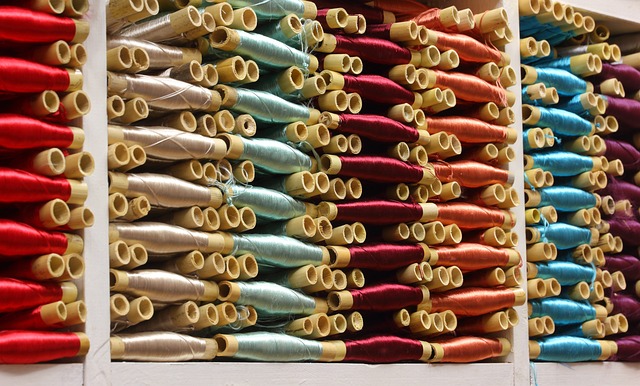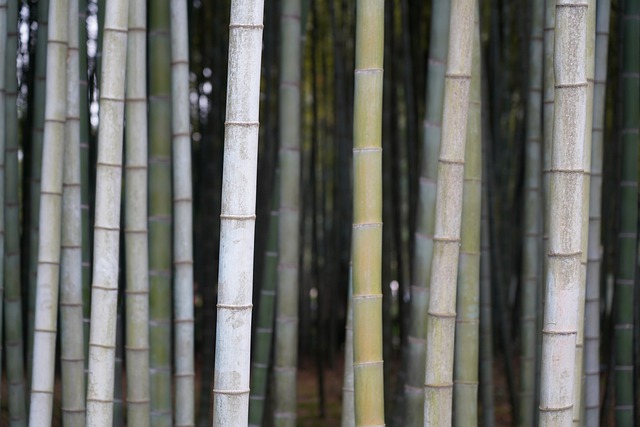
When it comes to sustainable fashion, bamboo clothing stands out for its low-impact manufacturing processes. As someone who values eco-friendly practices, I am excited to delve into the world of green manufacturing in the bamboo clothing industry.
In this article, we will explore the benefits of using sustainable raw materials, energy-efficient production techniques, waste reduction strategies, water conservation methods, ethical labor practices, and innovative packaging and shipping.
Get ready to discover how bamboo clothing is paving the way for a greener fashion industry.
Key Takeaways
- Bamboo clothing manufacturing offers numerous benefits for the environment, including a reduced carbon footprint, the use of renewable resources, and an environmentally friendly production process.
- The use of sustainable raw materials such as bamboo, which grows quickly and requires no pesticides or fertilizers, contributes to soil restoration and erosion prevention. Additionally, the use of renewable energy sources and energy-efficient production techniques helps decrease reliance on fossil fuels and reduces carbon emissions.
- Waste reduction and recycling play a significant role in green manufacturing of bamboo clothing, with the collection and repurposing of excess bamboo fibers and the implementation of recycling techniques for water and chemicals. These practices contribute to a circular economy, minimizing environmental impact and lessening strain on resources.
- Water conservation strategies, such as eco-friendly dyeing techniques and efficient water recycling systems, are crucial in bamboo clothing production. These strategies reduce water consumption, minimize harm to the environment, and contribute to overall sustainability.
The Benefits of Green Manufacturing for Bamboo Clothing
You’ll be amazed at the benefits of green manufacturing for bamboo clothing. When it comes to producing sustainable and eco-friendly garments, green manufacturing is the way to go.

One of the major advantages is that it significantly reduces the carbon footprint. By using renewable resources like bamboo, instead of traditional materials like cotton, we can minimize the environmental impact.
Additionally, green manufacturing techniques ensure that the entire production process is environmentally friendly. This means using non-toxic dyes and chemicals, as well as reducing water and energy consumption.
Another benefit is that bamboo clothing is biodegradable, so it won’t contribute to the growing problem of textile waste.
Overall, green manufacturing for bamboo clothing not only benefits the environment but also offers consumers a sustainable and stylish alternative.

Sustainable Raw Materials: A Key Component in Low-Impact Processes
When choosing materials for eco-friendly production, it’s important to prioritize sustainable options. One key component in low-impact processes is the use of sustainable raw materials.
As a manufacturer committed to green manufacturing, I understand the significance of choosing materials that have minimal environmental impact. That’s why I opt for bamboo as a primary raw material for clothing production.
Bamboo is a renewable resource that grows quickly and requires no pesticides or fertilizers. Its cultivation also helps in soil restoration and erosion prevention. Moreover, bamboo fabric is biodegradable, meaning it won’t contribute to the growing problem of textile waste.
Energy-Efficient Production Techniques in Bamboo Clothing Manufacturing
When it comes to sustainable energy sources and minimizing carbon footprint in bamboo clothing manufacturing, I believe it’s crucial to explore and implement energy-efficient production techniques.

By using renewable energy sources such as solar or wind power, we can significantly reduce our reliance on fossil fuels and decrease the carbon emissions associated with the production process.
Additionally, adopting energy-saving practices, such as optimizing machinery and equipment, can further contribute to minimizing our carbon footprint and creating a more sustainable future.
Sustainable Energy Sources
To minimize carbon emissions, consider using renewable energy sources like solar or wind power when manufacturing bamboo clothing. By harnessing the power of the sun or the wind, we can drastically reduce our reliance on fossil fuels and decrease our environmental impact.
Solar energy is abundant and readily available, making it an ideal choice for powering the production of bamboo clothing. The use of solar panels can generate clean electricity, which can be used to power machinery and equipment, reducing greenhouse gas emissions.

Another sustainable energy source to consider is wind power. By utilizing wind turbines, we can convert the wind’s energy into electricity, further reducing our carbon footprint.
Embracing renewable energy sources not only helps protect the environment but also promotes a more sustainable and responsible manufacturing process.
Minimizing Carbon Footprint
By harnessing renewable energy sources like solar or wind power, we can significantly reduce our carbon footprint.
As an individual, I strive to make sustainable choices that minimize my impact on the environment.

One of the ways I do this is by using energy-efficient appliances and light bulbs in my home.
I also make a conscious effort to unplug electronics when they are not in use.
Additionally, I have installed a programmable thermostat that helps regulate the temperature in my house, reducing the need for excessive heating or cooling.
When it comes to transportation, I opt for walking, biking, or using public transportation whenever possible.

Waste Reduction and Recycling in Green Manufacturing
You can reduce waste and recycle materials in green manufacturing processes for bamboo clothing.
As a sustainable fashion enthusiast, I am always looking for ways to minimize my environmental impact. One way to achieve this is by implementing waste reduction and recycling practices in the production of bamboo clothing.
In the manufacturing process, excess bamboo fibers can be collected and repurposed, reducing the amount of waste generated. Additionally, recycling techniques can be employed to reuse materials such as water and chemicals, reducing the need for fresh resources.
By adopting these practices, we can contribute to a more circular economy and lessen the strain on our planet’s resources.

Water Conservation Strategies in Bamboo Clothing Production
When it comes to eco-friendly dyeing techniques and efficient water recycling in bamboo clothing production, there are several key points to consider.
Firstly, eco-friendly dyeing techniques prioritize the use of natural and non-toxic dyes, minimizing harm to the environment.
Secondly, efficient water recycling systems are crucial in reducing water consumption during the dyeing process, ensuring that water is reused and not wasted.
Lastly, implementing these strategies not only benefits the environment but also contributes to the overall sustainability of bamboo clothing production.

Eco-Friendly Dyeing Techniques
Choose eco-friendly dyeing techniques to minimize the environmental impact of your bamboo clothing.
When it comes to dyeing bamboo fabric, there are several low-impact options available. One such technique is natural dyeing, which utilizes plant extracts to create vibrant colors without harmful chemicals. These natural dyes are biodegradable and pose no threat to the environment.
Another eco-friendly option is low-water dyeing, which reduces water consumption during the dyeing process. This technique uses less water and requires fewer chemicals, resulting in a smaller ecological footprint.
Additionally, consider using non-toxic dyes that are free from harmful substances such as heavy metals and AZO dyes.

Efficient Water Recycling
Efficient water recycling is a key component of sustainable dyeing techniques. As a manufacturer in the textile industry, I understand the importance of minimizing water usage and reducing our environmental impact.
By implementing efficient water recycling systems, we can drastically decrease the amount of fresh water needed for the dyeing process. This not only conserves a valuable resource but also reduces the discharge of wastewater into rivers and streams.
To achieve this, we have invested in advanced filtration systems that remove impurities from the wastewater, allowing it to be reused in subsequent dyeing cycles. This closed-loop system not only saves water but also reduces the amount of chemicals required for dyeing.
It’s a win-win situation for both the environment and our business, as we strive towards a more sustainable future.

Ethical Labor Practices in Low-Impact Manufacturing
It’s important to ensure that ethical labor practices are implemented in low-impact manufacturing of bamboo clothing. As a consumer, I want to know that the products I purchase are made with respect for the workers involved. This means fair wages, safe working conditions, and no exploitation. By supporting companies that prioritize ethical labor practices, I am contributing to a more sustainable and equitable fashion industry.
When it comes to bamboo clothing, it’s crucial to consider not only the environmental impact but also the social impact of its production. This includes the sourcing of raw materials, the manufacturing process, and the treatment of workers throughout the supply chain. Ethical labor practices go hand in hand with sustainable manufacturing, as they ensure that the people involved are treated with dignity and respect.
To achieve ethical labor practices in low-impact manufacturing of bamboo clothing, companies need to prioritize transparency and accountability. They should partner with suppliers who uphold fair labor standards and conduct regular audits to ensure compliance. Additionally, providing training and education opportunities for workers can empower them and improve their overall well-being.
Innovations in Packaging and Shipping for Eco-Friendly Bamboo Clothing
When it comes to packaging and shipping eco-friendly bamboo clothing, I’ve seen companies implementing innovative solutions to reduce waste and minimize their carbon footprint.

One of the most common practices is using recycled materials for packaging. Instead of traditional plastic bags, companies are opting for biodegradable options made from cornstarch or other plant-based materials. These bags can be composted or recycled, reducing the amount of waste that ends up in landfills.
Additionally, companies are exploring alternative shipping methods to minimize their carbon emissions. Some are using carbon-neutral shipping options or partnering with organizations that specialize in eco-friendly logistics.
Frequently Asked Questions
How Does Bamboo Clothing Contribute to Reducing Carbon Emissions?
Bamboo clothing contributes to reducing carbon emissions by being made from a sustainable and renewable resource. The manufacturing process of bamboo clothing also requires less energy and water compared to traditional fabric production methods.
What Are the Specific Sustainable Raw Materials Used in Bamboo Clothing Manufacturing?
I’m not sure about the specific sustainable raw materials used in bamboo clothing manufacturing. However, I can provide information about bamboo clothing’s low-impact processes and its contribution to reducing carbon emissions.

Are There Any Energy-Efficient Machinery or Technologies Used in the Production of Bamboo Clothing?
Yes, we use energy-efficient machinery and technologies in the production of bamboo clothing. By investing in eco-friendly equipment, we minimize our carbon footprint and contribute to a more sustainable manufacturing process.
How Does the Company Ensure Proper Waste Management and Recycling Practices in Their Manufacturing Process?
In our manufacturing process, we prioritize proper waste management and recycling practices. We have implemented a comprehensive system to ensure that all waste is handled responsibly and recycled whenever possible.
What Water Conservation Strategies Are Implemented in the Production of Bamboo Clothing?
In the production of bamboo clothing, we implement water conservation strategies that help reduce our environmental impact. These strategies include using water-efficient machinery and technologies, as well as recycling and reusing water wherever possible.
Conclusion
In conclusion, the green manufacturing processes used in bamboo clothing production offer numerous benefits.

From sustainable raw materials to energy-efficient techniques, waste reduction, and water conservation strategies, every aspect of the manufacturing process is designed to minimize environmental impact.
Additionally, ethical labor practices ensure fair treatment of workers. Innovations in packaging and shipping further contribute to the eco-friendly nature of bamboo clothing.
By choosing bamboo clothing, consumers can support a sustainable and responsible fashion industry.
